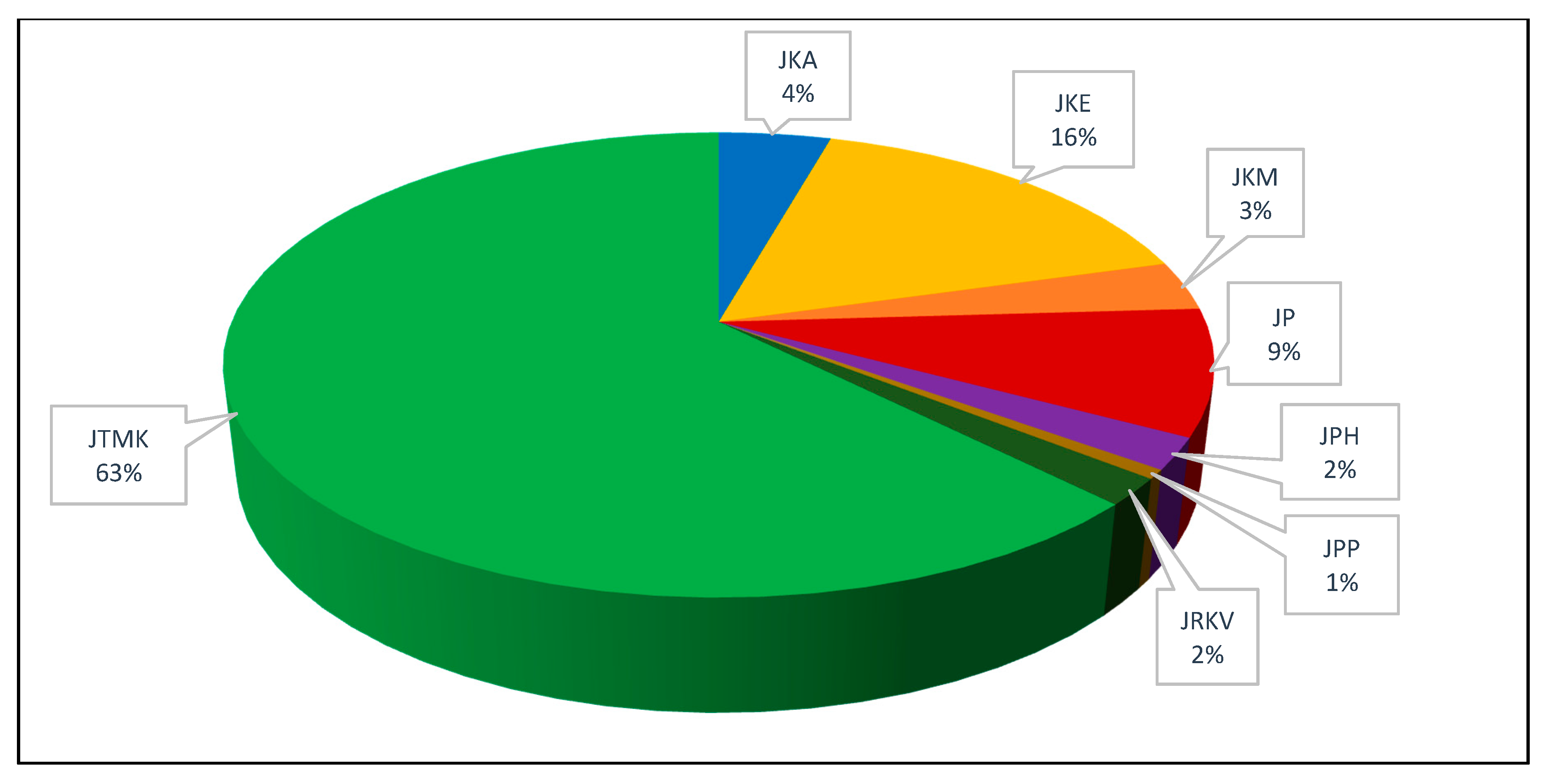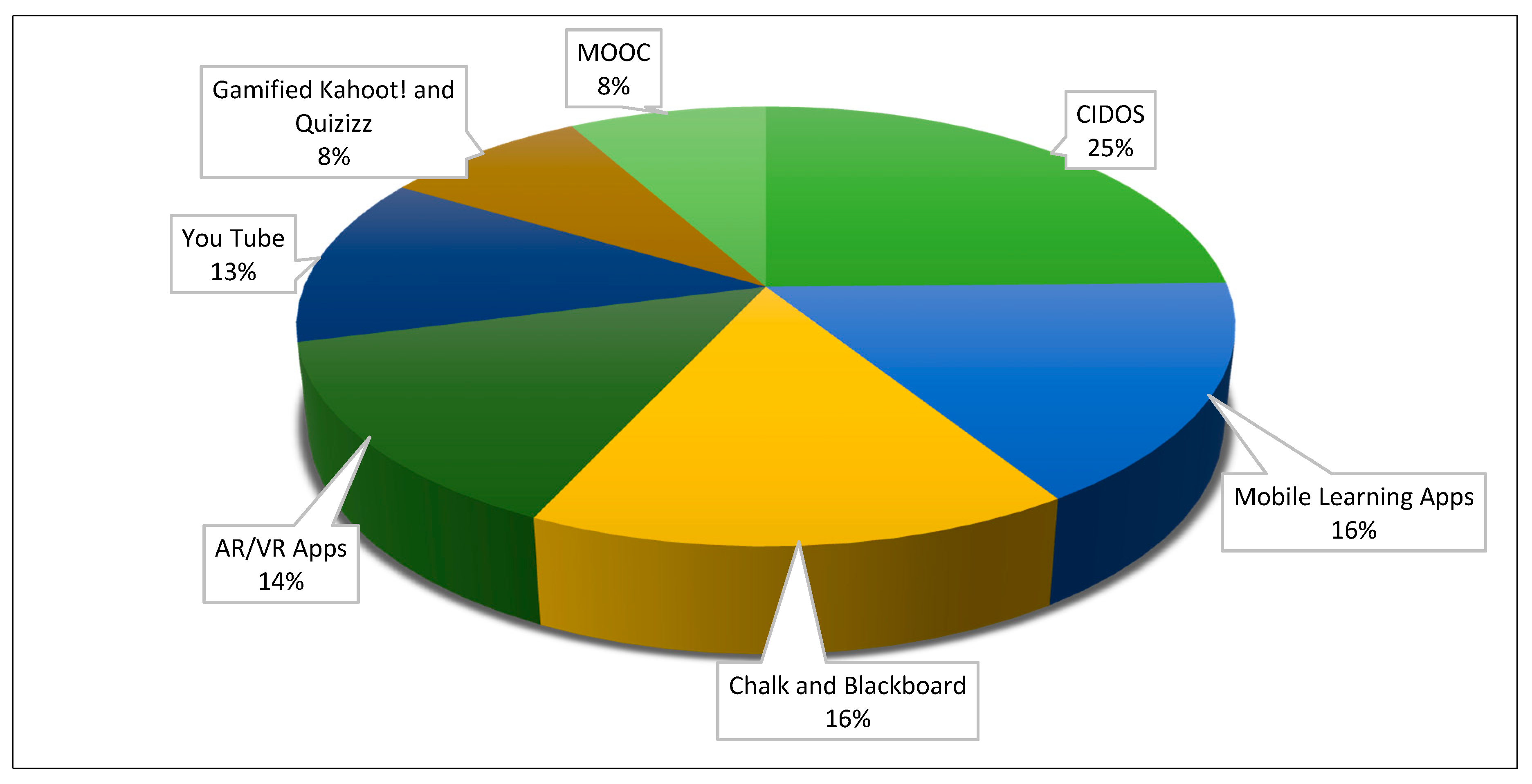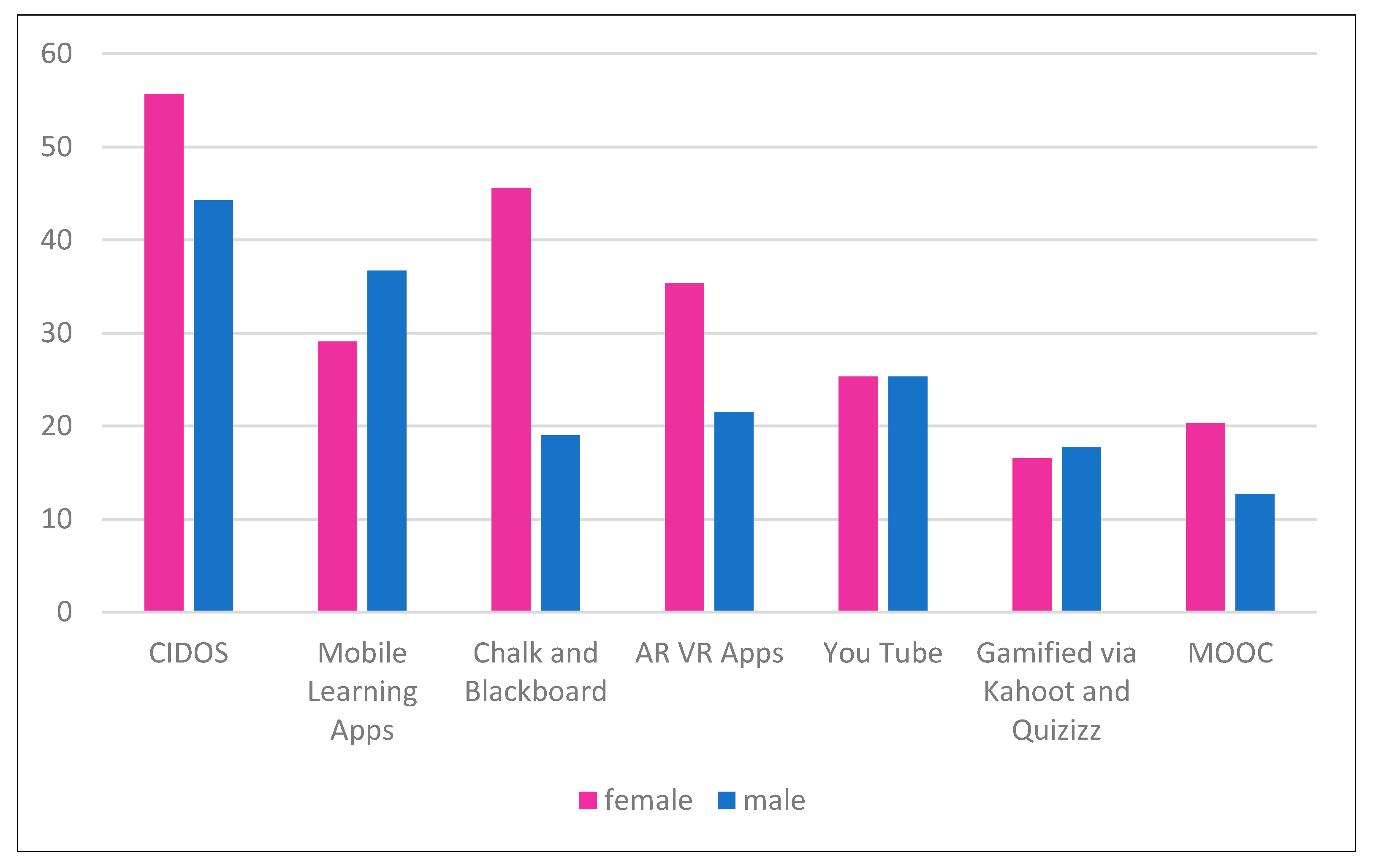Digital Learning Demand for Future Education 4.0—Case Studies at Malaysia Education Institutions
Abstract
:1. Introduction
2. Related Works
2.1. Advantage of Education 4.0 for Malaysia Education
2.2. Digital Learning Platform and Tool
3. Materials and Methods
3.1. Data Collection
3.2. Limitations
4. Results
5. Discussion
6. Future Directions
7. Conclusions
Author Contributions
Funding
Conflicts of Interest
References
- Maskuriy, R.; Selamat, A.; Ali, K.N.; Maresova, P.; Krejcar, O. Industry 4.0 for the Construction Industry—How Ready Is the Industry? Appl. Sci. 2019, 9, 2819. [Google Scholar] [CrossRef] [Green Version]
- Hussin, A.A. Education 4.0 Made Simple: Ideas For Teaching. Int. J. Educ. Lit. Stud. 2018, 6, 92–98. [Google Scholar] [CrossRef]
- Mogoş, R.I.; Bodea, C.N.; Dascălu, I.; Safonkina, O.; Lazarou, E.; Trifan, E.L.; Nemoianu, I.V. Technology Enhanced Learning for Industry 4.0 Engineering Education. Rev. Roum. Sci. Tech. Ser. Electrotech. Energy 2018, 63, 429–435. [Google Scholar]
- Ahmad, A.; Sirajuddin, P.T.S.; Mohamed, A.H. The Effectiveness of Training: Equipping and Enhancing ICT Knowledge and Skills among Polytechnic Lecturers in Producing Quality Highly Skilled Graduates. Adv. J. Tech. Vocat. Educ. 2017, 1, 1–05. [Google Scholar]
- Fisk, P. Education 4.0, the Future of Learning Will Be Dramatically Different, in School and Throughout Life. 2017. Available online: http://www.thegeniusworks.com/2017/01/future-education-young-everyone-taught-together (accessed on 27 March 2020).
- Sarah, D. Member Stories: Moving Towards Education 4.0. 2019. Available online: https://www.jisc.ac.uk/blog/member-stories-towards-higher-education-40-15-jan-2019 (accessed on 27 March 2020).
- Puncreobutr, V. Education 4.0: New Challenge of Learning. St. Theresa J. Humanit. Soc. Sci. 2016, 2, 2. [Google Scholar]
- Aberšek, B. Evolution of Competences For New Era or Education 4.0. In Proceedings of the XXV Conference of Czech Educational Research Association (CERA/ČAPV), Czech Budejovice, Czech Republic, 14–16 September 2018. [Google Scholar]
- Sinlarat, P. Education 4.0 is More than Education. In Annual Academic Seminar of the Teacher’s Council on the Topic of Research of the Learning Innovation and Sustainable Educational Management; The Secretariat Office of Teacher’s Council: Bangkok, Thailand, 2016. [Google Scholar]
- Deaconu, A.; Dedu, E.M.; Igret, R.S.; Radu, C. The Use of Information and Communications Technology in Vocational Education and Training—Premise of Sustainability. Sustainability 2018, 10, 1466. [Google Scholar] [CrossRef] [Green Version]
- Anttila, M.; Välimäki, M.; Hätönen, H.; Luukkaala, T.; Kaila, M. Use of web-based patient education sessions on psychiatric wards. Int. J. Med. Inform. 2012, 81, 424–433. [Google Scholar] [CrossRef]
- Hariharasudan, A.; Kot, S. A Scoping Review on Digital English and Education 4.0 for Industry 4.0. Soc. Sci. 2018, 7, 227. [Google Scholar] [CrossRef] [Green Version]
- Lin, M.-H.; Chen, H.-C.; Liu, K.-S. A Study of the Effects of Digital Learning on Learning Motivation and Learning Outcome. Eur. J. Math. Sci. Technol. Educ. 2017, 13, 3553–3564. [Google Scholar] [CrossRef]
- Daud, R.; Jalil, Z.A.; M.Gunawan, M.F. Community College Students’ Perception Towards Digital Learning In Malaysia. Procedia Soc. Behav. Sci. 2015, 195, 1798–1802. [Google Scholar] [CrossRef] [Green Version]
- Rahman, N.A.A.; Hussein, N.; Aluwi, A.H. Satisfaction on Blended Learning in a Public Higher Education Institution: What Factors Matter? Procedia Soc. Behav. Sci. 2015, 211, 768–775. [Google Scholar] [CrossRef] [Green Version]
- Starcic, A.I.; Terlević, M.; Lin, L.; Lebenicnik, M. Designing Learning for Sustainable Development: Digital Practices as Boundary Crossers and Predictors of Sustainable Lifestyles. Sustainability 2018, 10, 2030. [Google Scholar] [CrossRef] [Green Version]
- Chauhan, A. 11 Digital Education Tools for Teachers and Students. 2018. Available online: https://elearningindustry.com/digital-education-tools-teachers-students (accessed on 27 March 2020).
- Ismail, N.; Ayub, A.F.M.; Yunus, A.S.M.; Ab Jalil, H. Utilising CIDOS LMS in Technical Higher Education: The Influence of Compatibility Roles on Consistency of Use. Adv. Sci. Lett. 2017, 23, 7783–7787. [Google Scholar] [CrossRef]
- Terry, H. The Definition of Mobile Learning. 2018. Available online: https://www.teachthought.com/the-future-of-learning/a-definition-for-mobile-learning (accessed on 27 March 2020).
- Padmanathan, Y.; Jogulu, L.N. Mobile Learning Readiness among Malaysian Polytechnic Students. J. Inf. Syst. Technol. Manag. 2018, 3, 113–125. [Google Scholar]
- Yang, Q.-F.; Hwang, G.-J.; Sung, H.-Y. Trends and research issues of mobile learning studies in physical education: A review of academic journal publications. Interact. Learn. Environ. 2018, 1–19. [Google Scholar] [CrossRef]
- Shaari, R.; Ismail, Y.; Kok, R.A. Introduction to Massive Open Online Course (MOOC): The Issues and Challenges Using MOOC as A Teaching and Learning Method in Malaysian Polytechnic. Adv. J. Tech. Vocat. Educ. 2018, 6–8. [Google Scholar] [CrossRef]
- Blackmon, S.J.; Major, C.H. Wherefore Art Thou MOOC: Defining Massive Open Online Courses. Online Learn. 2017, 21, 195–221. [Google Scholar] [CrossRef] [Green Version]
- Rahim, M.I.; Shamsudin, S. Video Lecture Styles in MOOCs by Malaysian Polytechnics. In Proceedings of the 2019 3rd International Conference on Education and Multimedia Technology—ICEMT 2019, Nagoya, Japan, 22–25 July 2019; pp. 64–68. [Google Scholar]
- Kumar, J.A.; Al-Samarraie, H. MOOCs in the Malaysian higher education institutions: The instructors’ perspectives. Ref. Libr. 2018, 59, 163–177. [Google Scholar] [CrossRef]
- Fathil, N.F.; Osman, S.Z.M.; Jamaludin, R. An Analysis of Using Online Video Lecture on Learning Outcome: The Mediating Role of Student Interaction and Student Engagement. J. Educ. e-Learn. Res. 2016, 3, 57–64. [Google Scholar] [CrossRef] [Green Version]
- Ahmad, S. Video-Based Learning—The New Pitch and Resolution of Learning. 2015. Available online: https://elearningindustry.com/video-based-learning-new-pitch-resolution-learning (accessed on 27 March 2020).
- Saidin, N.F.; Halim, N.D.A.; Yahaya, N. A Review of Research on Augmented Reality in Education: Advantages and Applications. Int. Educ. Stud. 2015, 8. [Google Scholar] [CrossRef] [Green Version]
- Kesim, M.; Ozarslan, Y. Augmented Reality in Education: Current Technologies and the Potential for Education. Procedia Soc. Behav. Sci. 2012, 47, 297–302. [Google Scholar] [CrossRef] [Green Version]
- Akçayır, M.; Akçayır, G. Advantages and challenges associated with augmented reality for education: A systematic review of the literature. Educ. Res. Rev. 2017, 20, 1–11. [Google Scholar] [CrossRef]
- Yusof, A.A.; Adnan, A.H.M.; Mustafa Kamal, N.N.; Mohd, K.M.A.; Ahmad, M.K. Education 4.0 Immersive Learning with Spherical Videos (360°) and Virtual Reality (VR) Experiences. In Proceedings of the International Invention, Innovative & Creative (InIIC) Conference, Palace of Golden Horses, Kuala Lumpur, Malaysia, 2–3 November 2019; MNNF Publisher: Negeri Sembilan, Malaysia, 2019; pp. 52–60. [Google Scholar]
- Mohamad, S.N.M.; Sazali, N.S.S.; Salleh, M.A.M. Gamification Approach in Education to Increase Learning Engagement. Int. J. Humanit. Arts Soc. Sci. 2018, 4, 22–32. [Google Scholar]
- Jaafar, R.; Ismail, N.H. Gamification in Programming: Does Gamification Increase Student’s Motivation? Adv. J. Tech. Vocat. Educ. 2018, 2, 1–7. [Google Scholar]
- Rahman, R.A.; Ahmad, S.; Hashim, U.R. The effectiveness of gamification technique for higher education students engagement in polytechnic Muadzam Shah Pahang, Malaysia. Int. J. Educ. Technol. High. Educ. 2018, 15, 41. [Google Scholar] [CrossRef] [Green Version]
- Yildirim, I.; Sen, S. The effects of gamification on students’ academic achievement: A meta-analysis study. Interact. Learn. Environ. 2019, 1–18. [Google Scholar] [CrossRef]
- Wolf, J.; Lavrakas, P. Self-Administered Questionnaire. In Encyclopedia of Survey Research Methods; SAGE Publications: Thousand Oaks, CA, USA, 2013; pp. 804–805. [Google Scholar]
- Romli, R. Implementation of Cidos (E-Learning) Among Diploma in Accountancy Students in Politeknik Sultan Abdul Halim Mu’adzam Shah, Jitra, Kedah. In National Innovation and Invention Competition Through Exhibition (iCompEx); Unit Penyelidikan, Inovasi dan Komersilan POLIMAS: Kedah, Malaysia, 2016; pp. 1–8. [Google Scholar]
- Mohamad, S.N.M.; Salam, S. and Bakar, N. Lecturers’ Perceptions and Attitudes Towards the Usage of Online Learning at Polytechnic. Int. J. Sci. Commer. Humanit. 2014, 2, 2012–2015. [Google Scholar]
- Safie, A.; Wahid, S.Z. and Idris, N. Evaluating Student Perception Towards Application of Mobile Learning. In e-Proceeding National Innovation and Invention Competition Through Exhibition (iCompEx); Unit Penyelidikan, Inovasi dan Komersilan POLIMAS: Kedah, Malaysia, 2017. [Google Scholar]
- Sanmugam, A.T.; Ibrahim, L. Exploring Engineering Students’ Views on Learning English for TVET using MOOC. Adv. J. Tech. Vocat. Educ. 2018, 29–36. [Google Scholar] [CrossRef]
- Ahmad, K.A.; Adnan, A.H.M.; Azamri, N.M.; Idris, K.B.; Norafand, N.N.; Ishak, N.I. Education 4.0 Technologies for English Language Teaching and Learning in the Malaysian Context. In Proceedings of the International Invention, Innovative & Creative (InIIC) Conference, Palace of Golden Horses, Kuala Lumpur, Malaysia, 2–3 November 2019; MNNF Publisher: Negeri Sembilan, Malaysia, 2019. ISBN 978-967-17324-4-1. [Google Scholar]






| Digital Learning | Features | Activity | Type |
|---|---|---|---|
| Edmodo | To create online collaborative groups, administer and provide educational materials, measure student performance, and communicate with parents, among other functions. | Polls Quizzes Assignment Notes Blogs Award Badges Online | Tool |
| Socrative | To allows lecturers to create exercises or educational games | Quizzes Quick Question Class Count | System |
| Projeqt | To create a real-time dynamic presentation platform | Dashboard Slide Powerpoint | Platform |
| Thinglink | To save and share notes and observations about real-world spaces, situations, and artifacts. | Customized visual material | Tool |
| TED-Ed | To allows democratizing access to information, both for lecturers and students. | TED-style talks Discussion Sharing ideas | Platform |
| ClassDojo | To improve student behavior with instant feedback | Share photo, video, and announcement on class story Private message | Tool |
| eduClipper | To share and explore references and educational material | Virtual class Digital record | Platform |
| Animoto | To create a high-quality video in a short time | Audiovisual content | Tool |
| Kahoot! | To promotes game-based learning | Questionnaires Discussion Survey Education by gaming | Platform |
| Digital Learning | Researcher | Description |
|---|---|---|
| e-Learning | [18] | E-Learning is a learning platform that uses electronic technology to access learning courses anywhere and anytime. Curriculum information document online system (CIDOS) is an online learning platform developed by the Department of Polytechnic and Community College (JPPKK) for polytechnic lecturers and students. The platform allows students to access teaching materials such as notes, assignments, and videos also can perform quizzes and tests through the digital environment. |
| Mobile Learning Apps | [19,20,21] | It is one of the significant potential platforms that can be accessed at anytime and anywhere based on multiple mobile devices such as smartphones, iPods, tablets, and wearable technology. The emergence of various innovations in mobile has created a conducive learning environment among students to develop self-paced and self-study learning. Students can use many types of mobile learning applications such as Coursera, Google Classroom, or the learning course application downloaded in the Google Play store. |
| Open Learning Massive Open Online Course (MOOC) | [22,23,24,25] | MOOC is one of the social learning approaches that provide an open learning platform, through video content sharing on learning topics by social networks. This online learning is freely accessible through the web that enables students to learn skills in a new environment on their own. The platform covers a wide variety of course content that allows them to study online anytime. |
| Video-based | [26,27] | Video-based learning has become part of a new generation of students. They enjoy learning through YouTube, social blogging, and other video platforms. However, Fathil [26] has stated that using online video without active learning activities preserves a traditional environment in teaching and learning. |
| Augmented Reality or Virtual Reality Apps | [28,29,30,31] | This is a new teaching and learning model that has incredible capabilities to support the 4.0 education approach. The device has been redesigned with high-tech hardware that can create virtual scenery, 3D objects, and interactivity with students. Using AR and VR apps such as Aurasma, Layar, Google Expeditions, and other more, students can experience and engage in virtual learning. Using AR and VR promotes more effective teaching and learning, even though they are physically far from each other. |
| Educational Online Game | [32,33,34,35] | Gamification is a design based on game elements and principles to increase engagement and motivation students in learning. Several gamification platforms that been implemented included Kahoot! and Quizziz. Based on the previous research, gamification able to give a positive, moderately effect on the student’s achievement and exciting learning environment in developing students’ understanding. |
| No | Demographic | Indicator |
|---|---|---|
| AQ1 | Gender | Female, Male |
| AQ2 | Institution | Data obtained from 11 polytechnic Malaysia |
| AQ3 | Department | Data obtained from students of engineering and non-engineering field |
| AQ4 | Semester | 1 ≤ semester ≤ 9 |
| AQ5 | Intake | Community College, Sijil Pelajaran Malaysia (SPM) |
| AQ6 | CGPA | Cumulative Grade Pointer Average |
| No | Question |
|---|---|
| BQ1 | Have you ever know or heard about Education 4.0. |
| BQ2 | Choose which digital learning platform and tool that interests you most in class. Please stated why. |
| BQ3 | Which digital platform gives you easy access to get learning materials related to the course? |
| BQ4 | Choose digital learning platforms and tools that can increase your understanding of class. |
| BQ4 | Choose the digital learning activity that you interested in joining in the class. |
| BQ5 | Does digital learning have an impact on your understanding of knowledge? |
© 2020 by the authors. Licensee MDPI, Basel, Switzerland. This article is an open access article distributed under the terms and conditions of the Creative Commons Attribution (CC BY) license (http://creativecommons.org/licenses/by/4.0/).
Share and Cite
Bujang, S.D.A.; Selamat, A.; Krejcar, O.; Maresova, P.; Nguyen, N.T. Digital Learning Demand for Future Education 4.0—Case Studies at Malaysia Education Institutions. Informatics 2020, 7, 13. https://doi.org/10.3390/informatics7020013
Bujang SDA, Selamat A, Krejcar O, Maresova P, Nguyen NT. Digital Learning Demand for Future Education 4.0—Case Studies at Malaysia Education Institutions. Informatics. 2020; 7(2):13. https://doi.org/10.3390/informatics7020013
Chicago/Turabian StyleBujang, Siti Dianah Abdul, Ali Selamat, Ondrej Krejcar, Petra Maresova, and Ngoc Thanh Nguyen. 2020. "Digital Learning Demand for Future Education 4.0—Case Studies at Malaysia Education Institutions" Informatics 7, no. 2: 13. https://doi.org/10.3390/informatics7020013
APA StyleBujang, S. D. A., Selamat, A., Krejcar, O., Maresova, P., & Nguyen, N. T. (2020). Digital Learning Demand for Future Education 4.0—Case Studies at Malaysia Education Institutions. Informatics, 7(2), 13. https://doi.org/10.3390/informatics7020013






